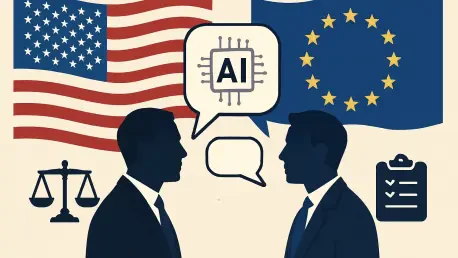In a world increasingly driven by artificial intelligence, where algorithms shape decisions from healthcare diagnostics to financial approvals, the regulatory landscape has become a critical battleground for balancing innovation with safety. As AI permeates every sector, the stakes for establishing robust governance have never been higher, with billions of dollars in investment and public trust hanging in the balance. This global challenge has thrust regulation into the spotlight, as governments scramble to address risks while fostering technological advancement.
Across the globe, AI regulation is evolving rapidly, with varying approaches reflecting cultural, economic, and political priorities. The European Union and the United States stand out as key players, wielding significant influence over how AI is developed and deployed worldwide. Their frameworks not only impact domestic markets but also set precedents for other regions, making an understanding of their policies essential for any organization in the AI space.
The scope of AI applications, spanning from autonomous vehicles to facial recognition, underscores the urgency of regulatory oversight to ensure safety and accountability. Effective frameworks aim to build trust among consumers and stakeholders while encouraging innovation through clear guidelines. As such, the interplay between regulation and technology development remains a defining factor in shaping the future of AI on a global scale.
Contrasting Regulatory Frameworks
EU’s Centralized AI Act
The European Union’s AI Act represents a landmark in tech governance, establishing a unified, risk-based approach to regulating artificial intelligence across member states. This legislation categorizes AI systems into tiers based on potential harm—unacceptable, high, limited, and minimal risk—with stringent requirements for high-risk systems like those used in hiring or law enforcement. Additionally, it imposes specific transparency and risk mitigation obligations on General Purpose AI models, ensuring broad accountability.
A notable feature of the EU AI Act is its extraterritorial reach, meaning companies outside the EU must comply if their AI systems impact EU citizens. With a phased implementation ongoing from this year through 2027, the Act is poised to serve as a global benchmark, much like the GDPR did for data protection. This centralized model offers clarity and consistency, setting a high bar for safety and ethical standards.
The Act’s comprehensive nature, however, comes with demanding compliance requirements, including detailed documentation, human oversight, and risk management protocols for high-risk applications. Organizations must adapt to these rules under the watchful eye of the EU AI Office and national authorities, facing significant penalties for non-compliance. This rigorous framework reflects the EU’s commitment to prioritizing fundamental rights alongside technological progress.
U.S.’s Fragmented State-Led Approach
In stark contrast to the EU’s unified system, the United States operates under a decentralized model where AI regulation largely falls to individual states. States such as Colorado, California, and Texas have introduced their own laws, each focusing on distinct aspects like transparency in decision-making, bias prevention, or sector-specific concerns. This patchwork creates a diverse but inconsistent regulatory environment across the country.
Without a federal AI law to harmonize these efforts, compliance becomes a complex puzzle for organizations operating in multiple states. Federal agencies, such as the Federal Trade Commission, step in to address AI risks using existing legislation, targeting issues like deceptive practices or discrimination. However, the lack of a cohesive national strategy often leaves gaps in oversight and enforcement.
This fragmented approach offers flexibility, allowing states to experiment with innovative policies like regulatory sandboxes for AI testing. Yet, it also poses significant challenges for businesses seeking uniformity in their operations. The absence of overarching federal guidance means companies must navigate a maze of varying requirements, often leading to increased costs and legal uncertainty.
Key Compliance Challenges in EU and U.S. Contexts
Navigating the divergent regulatory landscapes of the EU and the U.S. presents substantial operational hurdles for organizations deploying AI systems. The EU’s centralized AI Act demands rigorous adherence to detailed rules, such as mandatory human oversight and risk assessments for high-risk applications, alongside hefty fines for violations. In contrast, the U.S.’s state-by-state approach results in a mosaic of requirements that can differ widely, creating a compliance burden for multi-state operations.
Further complicating matters are the differences in enforcement mechanisms and penalty structures between the two regions. The EU employs a coordinated system with severe financial consequences—up to 7% of global turnover for major infractions—ensuring that compliance remains a top priority at the executive level. Meanwhile, U.S. penalties are generally less severe and vary by state, though federal agency actions signal growing scrutiny that could escalate risks for non-compliant entities.
For companies with cross-border operations, these disparities impact everything from system design to legal strategies. Aligning with the EU’s stricter standards often proves more practical, an approach sometimes termed “EU-plus,” which streamlines compliance by adopting the highest bar as a global baseline. Such a strategy can mitigate risks, reduce operational friction, and prepare businesses for potential tightening of regulations in other markets like the U.S.
Impact of Regulatory Differences on Market Dynamics
The contrasting AI regulatory environments in the EU and U.S. significantly shape global market dynamics, influencing how companies approach procurement and investment. Large enterprises and public sector bodies increasingly embed EU-style compliance requirements into their procurement processes, prioritizing vendors who can demonstrate adherence to high standards. This trend pushes organizations to align with stricter rules to secure contracts and maintain market access.
Investment decisions are also affected, as venture capitalists and institutional investors evaluate governance maturity as a key factor in assessing AI companies. Firms that proactively meet or exceed regulatory expectations often gain a competitive edge, attracting funding more readily than those lagging in compliance. This shift highlights how regulatory alignment is becoming a critical component of financial strategy in the AI sector.
Beyond procurement and investment, trust and compliance are emerging as powerful differentiators in the marketplace. Consumers and partners favor organizations that prioritize ethical AI practices, driving companies to integrate governance directly into product design. As a result, adherence to robust standards is transforming from a legal obligation into a strategic asset for gaining market share and building brand reputation.
Future Trends in AI Regulation and Compliance
Looking ahead, the trajectory of AI governance suggests a move toward stricter oversight, particularly in the U.S., where federal involvement is likely to grow in response to public and agency demands for accountability. While state-level regulations currently dominate, the increasing actions by federal bodies hint at a potential national framework that could unify disparate rules. Such a development would reshape the compliance landscape for American businesses.
Globally, the EU’s influence continues to set the tone for AI standards, with other regions likely to adopt similar risk-based approaches over time. Emerging practices like “compliance by design,” where regulatory requirements are embedded into AI systems from the outset, are gaining traction as a proactive way to address risks. This methodology ensures that governance is not an afterthought but a core element of development.
Additionally, data governance is becoming central to mitigating AI risks, as issues like bias and transparency often stem from underlying data quality. Aligning AI practices with privacy laws and adopting principles like data minimization will be crucial for compliance. Stakeholder expectations, from investors to consumers, are also evolving, pushing companies to demonstrate responsibility and foresight in their AI strategies to maintain trust and relevance.
Conclusion and Strategic Recommendations
Reflecting on the deep dive into EU and U.S. AI regulatory landscapes, the stark contrasts in their approaches underscore significant compliance challenges that businesses navigate with varying success. The EU’s centralized, stringent framework often clashes with the U.S.’s fragmented state-led model, creating a complex environment for global operations that demands strategic foresight.
To address these challenges moving forward, organizations should consider adopting the EU AI Act as a universal baseline, ensuring readiness for the most demanding requirements while simplifying adherence to less rigorous U.S. state laws. Prioritizing robust data governance emerges as a foundational step, tackling root causes of AI risks and aligning with parallel privacy regulations for comprehensive risk management.
Embedding compliance into the AI development lifecycle also stands out as a vital strategy, enabling companies to anticipate regulatory shifts and respond nimbly to stakeholder demands. By viewing governance as an opportunity rather than a burden, businesses can transform these challenges into competitive advantages, positioning themselves as leaders in responsible AI innovation for the long term.









